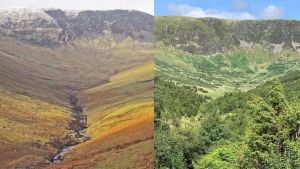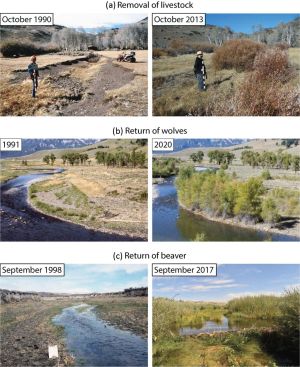Rewilding
Rewilding is the process of allowing ecosystems to return to a more natural state specifically with their original native plants, animals, microorganisms etc. In the past few years rewilding has gained popularity with many scientific journals reporting about rewiliding alongside material rewilding projects popping up across the world. Rewilding was first described and proposed in the early 1990's and 2000's by academics and activists in so-called North America.[1]
Early conceptions of rewilding were rooted in western conservation practices, which viewed rewilding as leaving "nature" to be "wild" without the influence of humans. An early example of a rewilding proposal is wolves being reintroduced into Yellowstone Park. This early examples is emblematic of early rewilding proposals, because they would mostly focus on reintroducing carnivores to their original habitats.[2] Over the years the idea of fortress conservation as a method of rewilding has been discarded and evolved- realizing that humans in fact are a part of nature and play important roles in maintaining healthy functioning ecosystems. The role of humans is evident in the fact that the majority of biodiversity on the planet is concentrated in Indigenous stewarded areas.
Allowing wild animals and native species of plants, microbes, mycorrhiza, etc to proliferate undisturbed through the aid of a symbiotic relationship with humans is key to sequestering carbon. A study published in the ‘Nature Climate Change’ journal[3] focused on only nine wild animals and found that they could collectively help sequester an additional 6.41 billions tons of carbon each year.[4]
Origins
Emanating from North America, the first call of Rewilders was to ‘restore’ and ‘rewild’ large tracts of land in order to generate the space and connections necessary to reintroduce large carnivores. Such calls were put forward by Michael Soule ́ and Dave Foreman, the latter of whom co-founded the Wildlands Project in 1991, now known as the Wildlands Network, and who went on to become co-founder of the Rewilding Institute. Both organisations have been pivotal in developing the scientific ideas underlining continental-scale rewilding networks (Carver, 2013). Foreman (1981) historically co-founded the environmental group ‘Earth First!’, a radical movement with roots in deep ecology that had wilderness protection at the heart of its vision. Michael Soule ́ , a conservation biologist, while not a radical environmental activist in the same sense as Foreman, can still be recognised as a wilderness proponent, seeking to provide the scientific basis for the realisation of large core areas of protected wilderness and landscape connectivity.
The scientific ideas behind early calls to rewild America were first published in a landmark paper by Soule ́ and Noss (1998), where the reintroduction of megafauna, and the creation of what they term the ‘three C’s argument: cores, carnivores and corridors’, were fundamental strategies for creating ‘self regulating land communities’ (Soule ́ and Noss, 1998):
Our principal premise is that rewilding is a critical step in restoring self-regulating land communities . . . Once large predators are restored, many if not most of the other keystone and ‘habitat-creating’ species (e.g., beavers, prairie dogs) . . . and natural regimes of disturbance and other processes will recover on their own . . . ‘wide-ranging predators usually require cores of protected landscape for secure foraging, seasonal movement, and other needs; they justify bigness.[5]
Bio-regionalism
See this video for information about rewilding with native plants and grasses on personal lawns: https://www.youtube.com/watch?v=XeF3d-hFfTY
Grasslands
https://besjournals.onlinelibrary.wiley.com/doi/10.1111/1365-2664.13338
Forests
Rewilding in forest ecosystems has received far less attention than rewilding studies/projects.[6]
It may not be clear precisely what rewilding is and foresters may feel they've been doing for some time what rewilders claim as theirs. However, whatever the reasons for the apparent lack of interest in rewilding amongst forest scientists, there seems substantially more to gain from participating in the contemporary debates than from ignoring them or letting them go on unchallenged. The emergence of rewilding to date manifests itself as another instance of the common problem of disciplinary and sectoral divisions - between two areas, forestry and conservation, that are profoundly interlinked and should be closely integrated. Moving forward it appears critical for forest scientists to engage more strongly and directly with rewilding, following the lead taken by some practitioners as noted here. The language of rewilding has considerable potential to bring foresters, conservationists and other stakeholders closer together - through recognising overlap and enabling conversations about shared goals. Rewilding can provide a conduit and framing via which foresters – often simplistically identified as commercial and production oriented – can demonstrate and explain their long-standing conservation efforts and achievements. It can refresh analysis of and debates around alternative silvicultural systems – such as continuous cover forestry - that can foster the ecological complexity and autonomy demanded by rewilding.[7]
Wolves and Beavers
See also: Bring Back the Beaver
In a paper published today in BioScience, “Rewilding the American West,” authors from CU Boulder, Oregon State University and several other institutions suggest using nearly 193,000 square miles (500,000 square kilometers) of federal lands in 11 states to establish a contiguous network based on potential habitat for the gray wolf and American beaver. Supporting those species through management changes on federal land would help control elk populations, support tree growth, boost biodiversity, improve water quality, increase carbon sequestration and restore riparian habitats, they said.[8]
Bison
See also: Red Meat Republic; Pte Oyate
Letting Bison return to the grasslands of the Great Plains has been shown to be a highly effective way to restore depleted and devastated lands. A nearly three decade study[9] was conducted at the ‘Konza Prairie Biological’ (KPBS) in Central Kansas comparing vegetation among sites with Bison, Cattle, and a control group with neither animals present. The results indicate a substantial 86% to 103% increase of native plants species richness and cattle had modest increases around 30% to 41% increase. Sites with Bison were also more resilient to extreme drought, increasing species richness post-drought whereas Cattle sites resulted in no net change at the end of the study.
Decolonization
The Nature-Culture Binary
Europe
Rewilding Europe
Turtle Island
American Prairie Foundation
On the American Prairie foundation's website they state: "Our vision is to fully restore the shortgrass prairie ecosystem in an identified region of Montana’s plains. The habitat diversity of the area includes expansive shortgrass prairie, sagebrush steppe, the Missouri River Breaks, nearby island mountain ranges, and the streams and riparian corridors that are woven throughout. Successful restoration means the wildlife species that are native to this region are present and fulfilling their natural ecological role, and that biodiversity is being conserved at all levels. When restored, the American Prairie Ecosystem will also contain ecologically meaningful populations of all non-extinct, native species present in the reference ecosystem (i.e., the Upper Missouri River ecosystem, circa 1800), with management focused on maximizing the integrity, complexity, and resilience of the system."[10]
Western Rewilding Network
"The Western Rewilding Network currently includes 92 threatened and endangered species across nine taxonomic groups: five amphibians, five birds, two crustaceans, 22 fishes, 39 flowering plants, five insects, 11 mammals, one reptile, and two snail species. The reserves with the greatest numbers of threatened and endangered species were the Mogollon Plateau and the Southern Rockies. Overall, livestock grazing poses by far the most common threat, followed by mining, logging and oil and gas drilling. In 7 of the 11 potential reserves, at least half of the listed species are threatened by livestock grazing. In all of the 11 potential reserves, average stream densities exceed 50 meters per km2, suggesting significant opportunities for high density beaver restoration."[11]
Worldwide Organizations/ Projects
- Mossy Earth (Scotland): https://www.mossy.earth/
Sources
- ↑ Dandy, N., & Wynne-Jones, S. (2019). Rewilding forestry. Forest Policy and Economics, 109, 101996. doi:10.1016/j.forpol.2019.101996
- ↑ Dandy, N., & Wynne-Jones, S. (2019). Rewilding forestry. Forest Policy and Economics, 109, 101996. doi:10.1016/j.forpol.2019.101996
- ↑ https://www.nature.com/articles/s41558-023-01631-6
- ↑ https://www.ecowatch.com/global-warming-solutions-rewilding.html
- ↑ Ward, K. (2019). For wilderness or wildness? Decolonising rewilding. Rewilding, 34–54. doi:10.1017/9781108560962.003
- ↑ Dandy, N., & Wynne-Jones, S. (2019). Rewilding forestry. Forest Policy and Economics, 109, 101996. doi:10.1016/j.forpol.2019.101996
- ↑ Dandy, N., & Wynne-Jones, S. (2019). Rewilding forestry. Forest Policy and Economics, 109, 101996. doi:10.1016/j.forpol.2019.101996
- ↑ https://www.colorado.edu/today/2022/08/09/scientists-call-western-rewilding-network-support-wolf-beaver-populations-improve
- ↑ https://www.pnas.org/doi/10.1073/pnas.2210433119
- ↑ https://americanprairie.org/rewilding/
- ↑ https://academic.oup.com/bioscience/article/72/10/931/6651305?login=false

